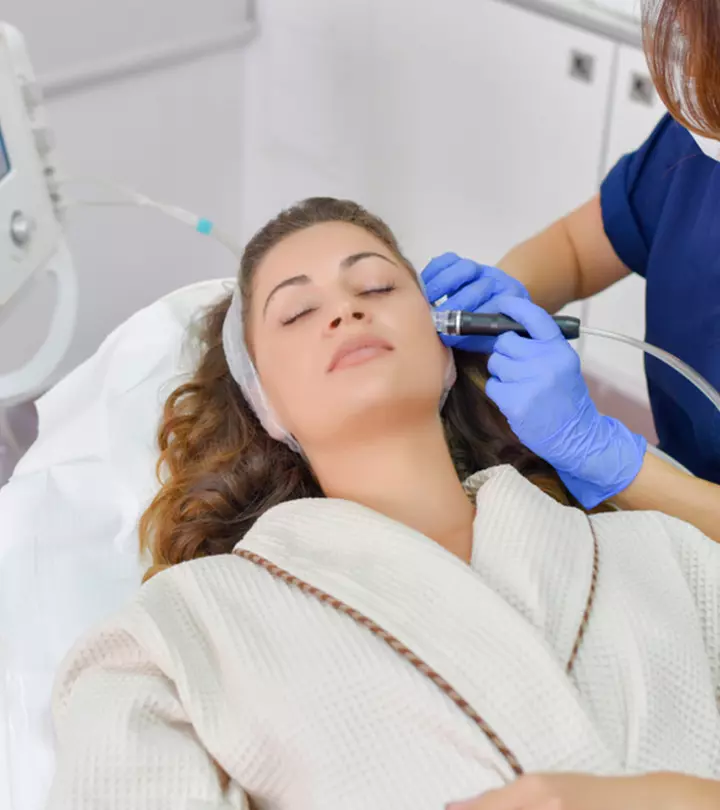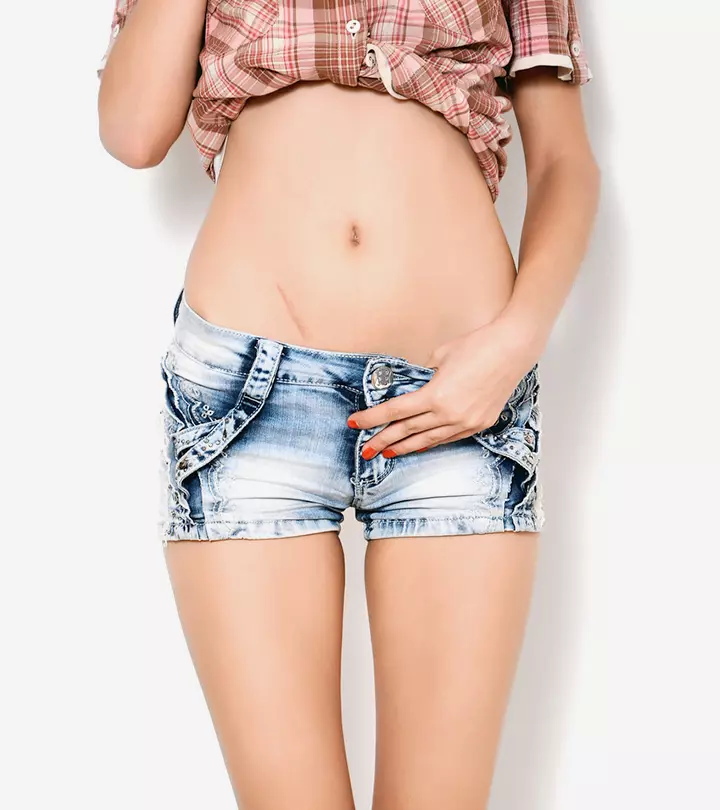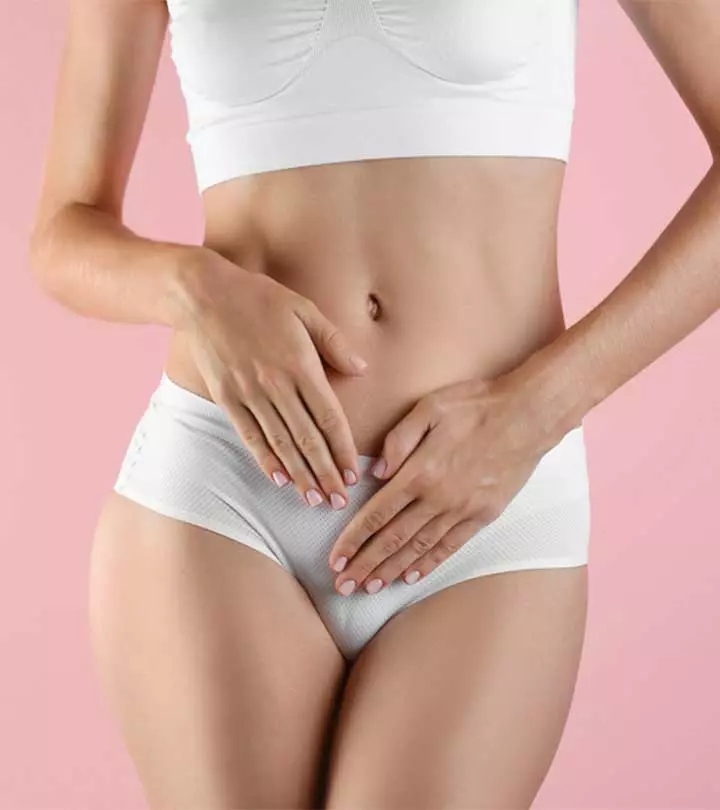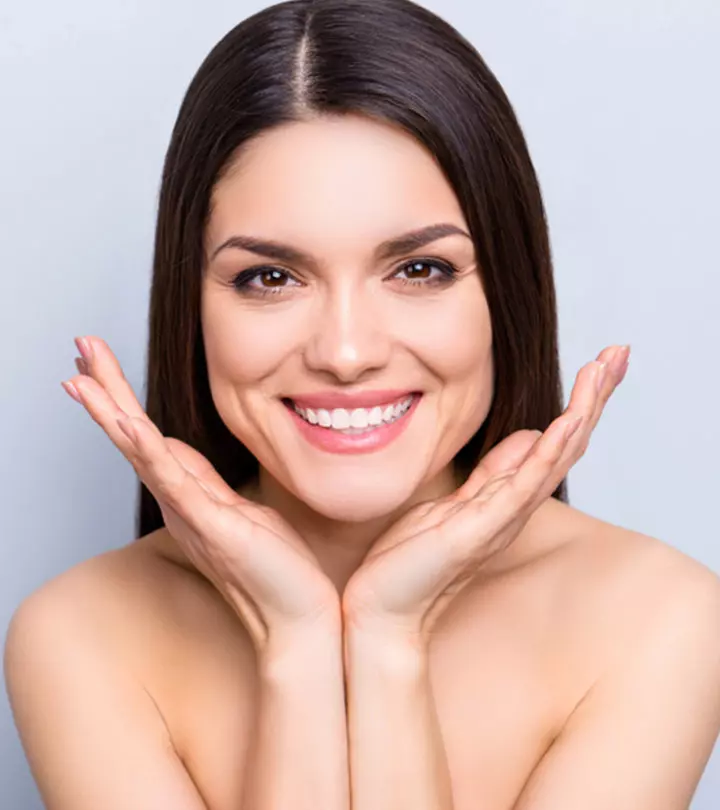Fraxel Laser Treatment: Types, Procedure, Cost, And Recovery
Aging skin doesn't have to be a botheration with this latest non-invasive treatment.

Image: shutterstock
FFraxel laser treatment is an intensive skin resurfacing procedure that helps reduce the aging signs. This non-invasive treatment can help correct spots, fade acne scars, and minimize the appearance of wrinkles and fine lines. If you are in your 30s and worried about the slightest hint of creases on your face, you may consider fraxel laser treatment.
However, before you get the treatment, it is best to consult a doctor and understand if it will suit your skin type. Keep reading to know everything about fraxel laser treatment, its types, risks, precautions to take, and cost.
In This Article
What Is Fraxel Laser? What Is It Used For?
Fraxel treatment is a skin resurfacing treatment that aims to improve the skin tone, texture, and radiance and minimize sun damage and scarring to give you younger-looking skin. This intensive, yet safe laser treatment can fade deep wrinkles and scars (like pockmarks, boxcar, and icepick scars)and reduce hyperpigmentation, dark spots, and patches to brighten the skin.
The name Fraxel comes from the word “fraction.” Fraxel is a device that uses fractional laser for targeted treatment to encourage the skin to produce more collagen and heal the area.
 Trivia
TriviaIn a 2021 survey conducted by the American Society for Dermatologic Surgery (ASDS), encompassing 3,527 participants, statistics highlighted a significant interest in laser treatments among consumers. Approximately 52% of respondents considered ultrasound, laser, light, and radiofrequency treatments for wrinkle-smoothing or skin tightening, while 48% contemplated laser/light therapy for facial redness, skin tone improvement, and scar treatment.
The Fraxel machine offers different types of laser resurfacing treatment for specific results. It has a mix of ablative and non-ablative laser treatments. Let’s take a deeper look.
Key Takeaways
- The different types of Fraxel laser treatments are repair, restore, and dual.
- You should avoid smoking, sun exposure, and waxing before a Fraxel procedure.
- You may feel a mild pricking sensation, but the medical expert will apply numbing cream to prevent any pain.
- You may encounter some side effects like swelling, redness, and purging after the treatment.
Different Types Of Fraxel Lasers
1. Fraxel Re:pair
Fraxel re:pair is the most aggressive of all Fraxel machines and uses fractional CO2 or ablative laser. Ablative lasers wound the skin and remove the outermost layer to stimulate the growth of collagen fibers. When the skin regrows, you will notice a tighter and smoother appearance. This powerful laser treatment for acne scars, among other skin concerns, can significantly improve the skin’s texture and appearance. However, there are many laser treatments for acne scars that you can consider per your issue. However, the doctor’s discretion is crucial.
Fraxel re:pair can treat irregularities like:
- Age spots
- Deep wrinkles and lines
- Deep acne scars
- Melasma
- Hyperpigmentation
- Surgical scars and other types of deep scar
Since it is a wounding treatment, your body needs time to heal before you can resume normal activities. Patients may experience redness, crusting of the skin, swelling, and even slight bleeding after the procedure. The treated area should also be kept protected from the sun rays.
2. Fraxel Restore
Fraxel Restore is a non-ablative laser procedure and uses Erbium laser at a wavelength of 1550 nm to heat the skin and stimulate collagen production. Unlike Fraxel re:pair, Fraxel restore does not remove the outer layer, making it a gentle option with minimal downtime.
Fraxel Restore is best for issues like:
- Brown spots
- Acne scars and rosacea
- Fine to moderate wrinkles
- Sun-damaged skin and discoloration
- Epidermal melasma
This treatment is suitable for the face, neck, chest, and hands. Once the procedure is done, you should see a significant visible difference in the appearance of wrinkles, acne scars, or any unevenness in skin tone. Since the Fraxel restore treatment is gentle, normal activities can be resumed within 2-3 days.
3. Fraxel Dual
Fraxel Dual is the latest in Fraxel treatments that combine the benefits of both ablative and non-ablative lasers. Fraxel Dual uses two wavelengths (1550 nm and 1927 nm) – one targets the issues at the surface level, while the other goes deeper to target deep wrinkles and scars.
Fraxel Dual can address issues like:
- Acne scarring (including deep scars)
- Fine lines and deep wrinkles
- Poor skin texture
- Age spots
- Signs of photoaging and UV damage
Fraxel Dual can be used on the face, neck, chest, arms, back, and legs. Here is a comparative overview of the three laser treatments to help you get a clear picture.
Comparison Of Fraxel Laser Treatments
| Laser Treatments | Fraxel Re:pair | Fraxel Restore | Fraxel Dual |
|---|---|---|---|
| Type | Ablative | Non-ablative | Mix of non-ablative and ablative |
Recovery (May vary) | A week | 1-2 days | A week |
Procedure Sessions (May vary) | 1-3 | 4-6 | 1-3 |
Targeted Skin Issues |
|
|
|
Duration Of Treatment | 45 minutes | 30 minutes | 15 minutes |
If you plan to undergo Fraxel treatment, consult a dermatologist to learn if you are an ideal candidate and what type of laser treatment you may need. Depending on that, you may start preparing for the procedure.
Preparations For Fraxel Laser Treatment
There are specific steps involved before you go for a Fraxel laser treatment:
- Discuss the outcomes of the treatment and your expectations.
- Avoid smoking for a few weeks before the treatment.
- Avoid excessive sun exposure without adequate sun protection.
- Avoid using retinol and topical products containing active ingredients like AHAs and BHA.
- Avoid waxing or shaving your face a few days before the procedure.
These are some specific steps you need to follow before you undergo a Fraxel laser treatment. Let us find out how this process works in the next section.
How Does Fraxel Laser Work?
Fraxel laser uses fractional technology to create micro-injuries in the skin to stimulate collagen production and the renewal of skin cells. It produces tiny laser columns that promote skin repair and replace damaged cells with healthy ones. This creates controlled injuries in the skin, which triggers the body’s healing process. This procedure improves the texture and tone of the skin by targeting scars, wrinkles, and pigmentation. However, the intensity of the treatment varies as well as the recovery time. It may require multiple sessions depending on the condition. Make a note: If you are specifically looking for anti-aging treatments, there are many other options, such as Microdermabrasion, dermal fillers, etc., that you can explore at your convenience.
Your dermatologist may give you a list of general dos and don’ts and specific instructions to follow depending on your skin condition, type, and any medication that you use (topical and oral). Follow them religiously. In the next sections, we have answered some common questions regarding the treatment, costs, recovery, and other aspects of Fraxel treatments. Take a look.
What Is The Cost Of Fraxel Laser Treatment?
The cost of a single sitting of ablative Fraxel laser treatment is about $2,000, and non-ablative treatment is $1144. However, this may change as per the location, clinic, and experience of the medical esthetician performing the treatment.
Is Fraxel Laser Treatment Painful?
It depends on your pain tolerance level. You may feel a mild pricking sensation. However, the medical practitioner will apply a numbing cream to the target area to prevent any discomfort.
In this blog, the blogger details their first experience with Fraxel, a fractionalized CO2 laser treatment for acne scars, performed by their dermatologist, Dr. Six Foronda. She recounts, “Despite my low pain threshold, I was able to tolerate the very uncomfortable heat from the machine. It just got painful when the light passed through my forehead, nose and temples (i).”
What Are The Side Effects Of Fraxel Laser Treatment?
Immediately after the treatment, you may experience:
- Redness
- Swelling
- Purging and whiteheads (the doctor may give antibiotics)
Rare side effects include:
- Scarring
- Discoloration
- Changes in skin texture
- Uneven bumps and depression
- Cold sores and infection
- Hyperpigmentation
How Long Does The Effect Of A Fraxel Treatment Last?
The results may last about a year. However, the time may vary, depending on your skin condition and age. With 1550 nm wavelength lasers, you may need three to five sessions in a gap of four weeks. You may continue to see improvements for the next three to six months after the treatment.
 Trivia
TriviaHow Many Sessions Of Fraxel Laser Do You Need?
Most people require at least two to four sessions to see the ideal results. However, the number of touch-up sessions may vary, depending on your age and skin condition.
How To Heal Faster From Fraxel Laser Treatment
The aftercare is crucial for proper healing. Here are a few dos and don’ts:
- Clean the treated area.
- Avoid smoking and excessive alcohol consumption.
- Avoid strenuous exercises and activities that may cause sweating.
- Avoid swimming as the pool water contains chlorine.
- Avoid UV exposure.
- Use non-irritating and non-comedogenic skin care products.
- Avoid abrasive products and active ingredients like AHAs, BHA, toners, and retinol.
- Use mild moisturizing creams and lotions.
- Use sunscreen every day.
- Avoid bleaching, shaving, and waxing the treated area.
Follow all these until the skin heals completely. After that, you can go back to your normal skin care and makeup routine.
Fraxel laser treatment is a non-invasive treatment where Fraxel lasers are used to stimulate collagen production. This procedure is used to treat age spots, acne scars, wrinkles, and hyperpigmentation. While Fraxel laser is not a painful procedure, you may feel a mild pricking sensation while it’s done. You may also experience side effects such as redness, swelling, and discoloration. Ensure that you clean the affected area properly and moisturize it regularly to allow your skin to heal well. It is recommended that you consult a dermatologist to understand the procedure before you decide to go for it.
Frequently Asked Questions
Does Fraxel thicken skin?
Yes, Fraxel laser treatment stimulates collagen production which in turn thickens your skin.
Does Fraxel reduce pore size?
No, Fraxel laser does not reduce pore size but helps reduce the appearance of pore size.
Can I wash my face after Fraxel?
Wait a few hours after Fraxel laser treatment to wash your face. Use a gentle cleanser and rinse it off with lukewarm water to keep the area clean.
What is better than Fraxel laser?
Ultherapy is better than Fraxel laser. It requires no downtime and results are usually seen after one session. Fraxel treatment requires a couple of days of downtime and a few sessions to see the results.
A YouTuber spills the deets on her first Fraxel Dual Laser Treatment in the below video. This $1,500 skincare journey targets sun damage, wrinkles, acne scars, and more. Hit the play button now!
Personal Experience: Source
StyleCraze's articles are interwoven with authentic personal narratives that provide depth and resonance to our content. Below are the sources of the personal accounts referenced in this article.
(i) My First Fraxel Experience: A Giant Leap In Rehabilitating My Scarred Skinhttp://herroyalbleakness.blogspot.com/2012/10/my-first-fraxel-experience-giant-leap.html
References
Articles on StyleCraze are backed by verified information from peer-reviewed and academic research papers, reputed organizations, research institutions, and medical associations to ensure accuracy and relevance. Read our editorial policy to learn more.
- Update on Fractional Laser Technology
https://www.ncbi.nlm.nih.gov/pmc/articles/PMC2921736/
Read full bio of Dr. CP Thajudheen
Read full bio of Ramona Sinha
Read full bio of Anjali Sayee
Read full bio of Swathi E




























Community Experiences
Join the conversation and become a part of our empowering community! Share your stories, experiences, and insights to connect with other beauty, lifestyle, and health enthusiasts.